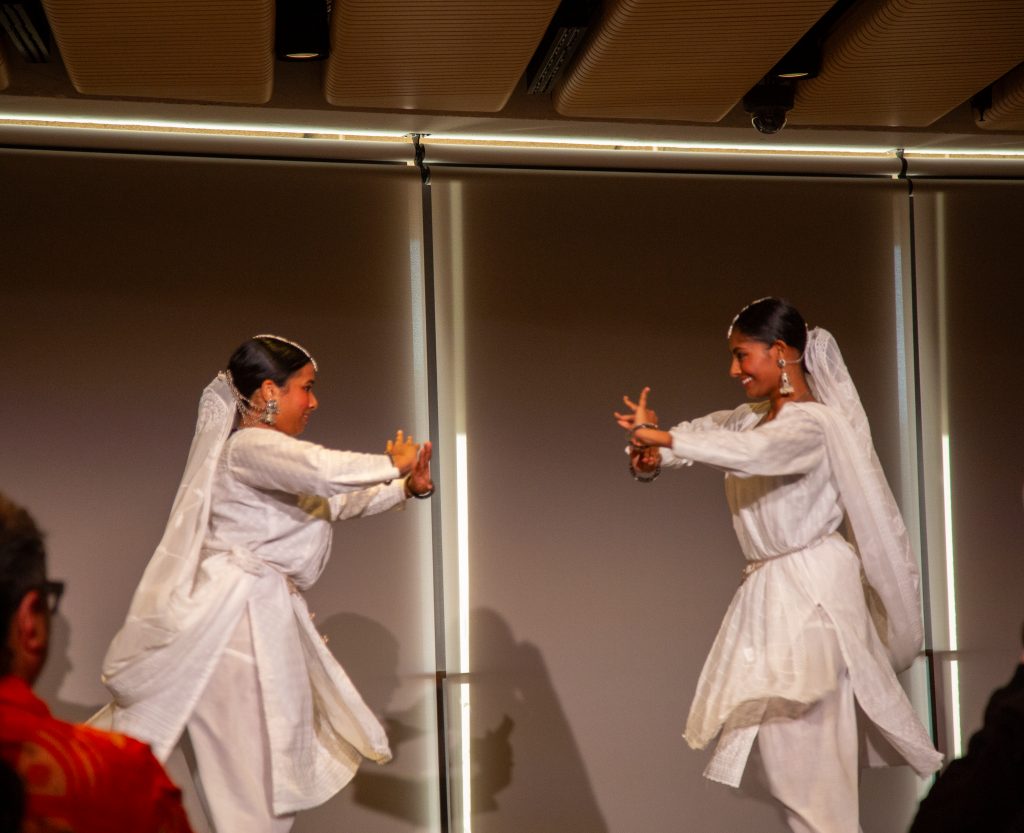Over nine months, Diversity Arts Australia has produced the InterGenerate Program, in which selected art mentees and mentors from culturally diverse backgrounds facilitated conversations and projects in their disciplines.
Selected artists showcased the culmination of their projects at Sydney Opera Houseʼs Centre of Creativity in late August 2024 through talks and performances. The breadth of artistry on display spanned traditional Indian dance and textile presentations founded on Taoist and Islamic beliefs. With mentors Lindy Lee, Khaled Sabsabi, and Anandavalli providing extensive cultural mentorship, InterGenerate was a moving display of talent and heritage.
“The liver has lodged a petition in court,” dancer Vineetha Menon announced during her performance. She recites the couplets of Sufi artist Abida Parveen, which chronicles madness in love. The loss of sense and self heightens with each couplet, as the loved one in the subject experiences belief, devotion and rapture. Caught in the web of a blissed and torturous state, the subject moves between pierced eyelids and a body wreathed in funereal white. The identity and the gender of the beloved is a secret — and the public acts as the omniscient presider. Under Anandavalliʼs tutelage, Lingalayam Dancers Menon, Dhanya Karthieyan and Aditi Manoharan perform a dual panel of classical Indian dance accompanied by the music of Ghazals and Qawwali. Sufi, the mystical dimension of Islam shines in the hybrid artwork presented — as the Ghazal and the dance come together through the interpreted piece. Traditionally recited in Urdu, Persian, and Hindi, Qawwali is translated into English and performed in a spoken-word context preceding the dance.
To follow, Karthieyan and Manoharan take over with a duologue to Qawwali ʻMan Kunto Maulaʼ performed by Abi Sampa and the Orchestral Qawwali. Resplendent in white, the two dancers move joyously to a statement by the Prophet Mohammed which repeats in sequence. The journey is an ancient one, melding dance with the language of poetry. While dancers sourced inspiration and knowledge from their grandparents and old CDs, there was also Google to guide them whenever confusion arose. Anandavalliʼs work presented with the Lingalayam dancers served as a poignant buffer between past and present.
Mentored artist Angie Pai presented a moving panel on restorative stability after undertaking a Northern Rivers residency under mentor Lindy Lee. She revisited the emotional terrains of shame and racial abuse present across her upbringing as a Taiwanese migrant in Australia. With an anchored and inimitable background at the intersection of art, social science and relational psychology, Paiʼs’s work’s ethos concerns the human condition and the diverse lived experience. Unsurprisingly, Pai intimately understands that precise data sets are needed for personalised interventions. Working with her mother on past hybrid video works was one of the many instances in which her art spoke from ancestry and connection.
Upriver, Pai, and Lee could expand on a body of work away from time and burnout constraints. Their shared heritage was their armour. Her textile works on Lindyʼs kept fabric, and seal works were hewn with remnants of Paiʼs extended family line in Taiwan. For Pai and Lee, the meaning of life depends heavily on what you decide to create and harness the emotions that grid defence mechanisms are the only outward byproducts of the soul.
Lindy Lee began her portion of the talk with a footnote or an old wives tale: ʻThe woman and her spirit separated. Which Chiʼen are you?ʼ The story from Case 35 of The Gateless Gate delves into the fractured life of young woman Chʼien, who is torn between her family and romantic woes and takes a boat upriver to be with a fated fiance. It is revealed that Chʼienʼs soul has been bedridden in her family home all this time. The splintering of the two ends when the Chiʼen in corporeal form returns home, and the two embrace and become one again. While the shadow is a Jungian concept, in Buddhist doctrine, this feeling of separation between self and other, heart and mind, spirit and body, presides over human suffering. This story is what Lee sustains as the forces that guide migrants towards artmaking. ʻThereʼs a meaningful connection we must make with this life,ʼ Lee says. And harnessing the art that they shared is the first step in reconciliation. She maintains that
Faith, community, craft, and culture are the building blocks of An.Other Collective, a diverse sisterhood of Muslim artmakers across Sydney and Melbourne. Mentored by Khaled Sabsabi, the network’s representatives documented their mentorship through curatorial artistsʼ’ journals that dove into the intricacies of cultural perspectives native to Western Sydney artists.
As surveyed by Sabsabi, the process included multiple studio visits and discussions outlining each step of the sketchbook entries. Vina Purwantoroʼs entry focused on the formation of birds and nature in every day’s dawning. To the artist, time is shed and regained in cycles. From the ACE Parallax Project, Della Indrada juxtaposed traditional Indonesian portraiture and Batik fashion with the gradient of punchy pop art. Naila Masagosʼ mark-making took the abstract and Islamic lettering, and Wasiela Noorjamsiʼs faith-based practice appraised the Islamic Hadith as soul-work in her creative piece. The details are not to be missed: From geometric sequences to shiny, digital interfaces of Islamic scripture to street photography capturing the slats of dawn in a foreign city, a kaleidoscope of talent is on display.
From mentor to mentee, InterGenerate’s artistry extracted something deeper than methodology. The byproduct of time, cultural interconnectivity, collaborative work, and conversation has yielded a meaningful and sound landscape for Australiaʼs next generation of diverse artists to seize centre stage.

